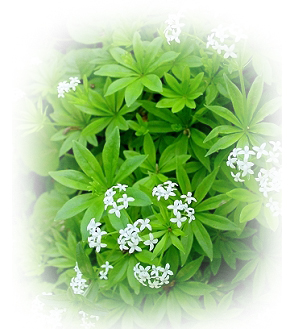Sweet Woodruff
|
|
| Galium odoratum
Rubiaceae
“Wood” in the common name refers to the fact that sweet woodruff grows wild in the woods. “Ruff” comes from the French meaning rouelle, relating to the arrangement of the leaves around the stem. In Germany for May Day the traditional May wine, Waldmeister-Bowle is drunk when sweet woodruff is in full bloom, involving a ceromony where people go into the woods to pick bunches, then using earthenware jugs/crock white wine is added and buried for 12 hours to chill at earth temperature. The sweet woodruff is then strained and “makes a man merri” when added to a wine cup of champagne and strawberries. |
|
| In centuries past strewing herbs in bunches was the way to freshen the air; garlands were hung in churches, strewn on domestic floors, sprinkled in potpourri, linens, stuffed into mattresses and herb pillows. Deters moths and other insects. The coumarin in the leaves develops its sweet hay scent only when the plant is dried. Can have a blood thinning effect if eaten in large amounts – dizziness and vomiting can occur. Anyone taking coumarin or blood thinners (medication) should avoid eating the flowers. Coumarin is found in several plants, including tonka beans, lavender, licorice, strawberries, apricots, cherries, cinnamon, and sweet clover. | |
|
In the Garden
Leaves are deep green whorls of six to eight around the square stem. Small white, funnel shape flowers appear in clusters in May. Flowers are sweet smelling, with a grassy, vanilla flavor and nutty undertone, foliage has no scent when freshly picked; but soon the sweet aroma of newly mown hay is released and the smell intensifies as the plant dries. Sweet Woodruff can grow in almost any type of soil but especially well-drained, rich soil, prefers shade but will adapt to partial shade. Can grow from seed but slow to germinate, it is easier to divide in spring or autumn. Once established it will self seed freely, spreads also by stolons (underground runners). May be invasive! In the Kitchen |
|



